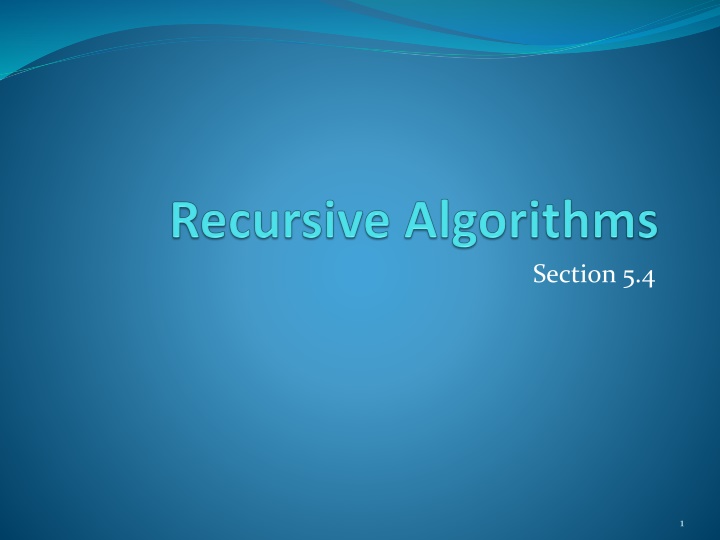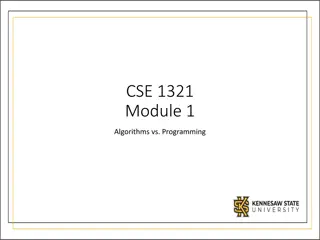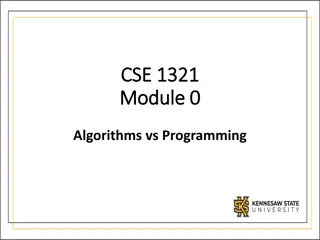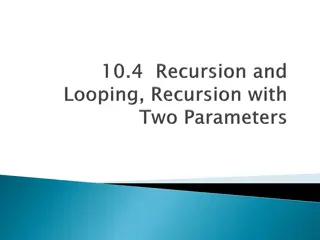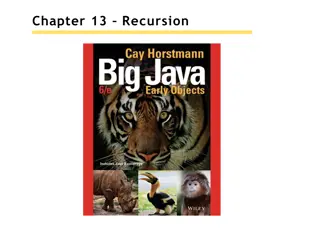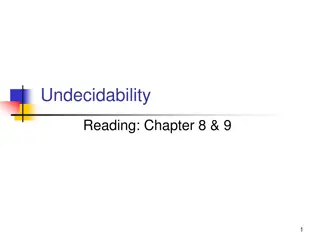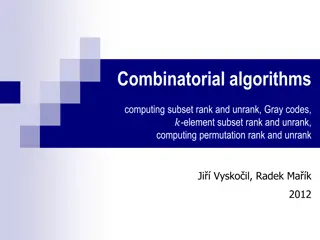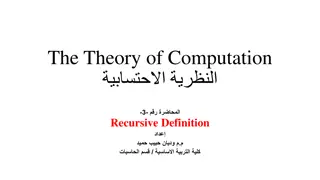Recursive Algorithms in Computing
Explore recursive algorithms in computing, including the definition, examples like factorial, exponentiation, GCD, and modular exponentiation. Dive into the concept of solving problems by breaking them into smaller instances, ensuring termination with known solutions.
Download Presentation

Please find below an Image/Link to download the presentation.
The content on the website is provided AS IS for your information and personal use only. It may not be sold, licensed, or shared on other websites without obtaining consent from the author.If you encounter any issues during the download, it is possible that the publisher has removed the file from their server.
You are allowed to download the files provided on this website for personal or commercial use, subject to the condition that they are used lawfully. All files are the property of their respective owners.
The content on the website is provided AS IS for your information and personal use only. It may not be sold, licensed, or shared on other websites without obtaining consent from the author.
E N D
Presentation Transcript
Section Summary Recursive Algorithms Proving Recursive Algorithms Correct Recursion and Iteration (not yet included in overheads) Merge Sort 2
Recursive Algorithms Definition: An algorithm is called recursive if it solves a problem by reducing it to an instance of the same problem with smaller input. For the algorithm to terminate, the instance of the problem must eventually be reduced to some initial case for which the solution is known. 3
Recursive Factorial Algorithm Example: Give a recursive algorithm for computing n!, where n is a nonnegative integer. Solution: Use the recursive definition of the factorial function. procedure factorial(n:nonnegative integer) if n = 0 then then return return 1 else return return n (n 1) {output is n!} Assignment: Implement this algorithm. 4
Recursive Exponentiation Algorithm Example: Give a recursive algorithm for computing an, where a is a nonzero real number and n is a nonnegative integer. Solution: Use the recursive definition of an. procedure power(a:nonzeroreal number, n:nonnegative integer) if n = 0 then then return return 1 else return return a power (a, n 1) {output is an} Assignment: Implement this algorithm. 5
Recursive GCD Algorithm Example: Give a recursive algorithm for computing the greatest common divisor of two nonnegative integers a and b with a < b. Solution: Use the reduction gcd(a,b) = gcd(bmoda, a) and the condition gcd(0,b) = b when b > 0. procedure gcd(a,b:nonnegative integers with a < b) if a = 0 then then return return b else return return gcd (bmod a, a) {output is gcd(a, b)} Assignment: Implement this algorithm. 6
Recursive Modular Exponentiation Algorithm Example: Devise a a recursive algorithm for computing bnmod m, where b, n, and m are integers with m 2, n 0, and1 b m. Solution: (see text for full explanation) procedure mpower(b,m,n:integers with b > 0 and m 2, n 0) if n = 0 then then return return 1 else if nis even then then return return mpower(b,n/2,m)2 mod m else return return (mpower(b, n/2 ,m)2 mod m b mod m) mod m {output is bnmod m} 7
Recursive Binary Search Algorithm Example: Construct a recursive version of a binary search algorithm. Solution: Assume we have a1,a2, , an, an increasing sequence of integers. Initially i is 1 and j is n. We are searching for x. procedure binary search(i, j, x : integers, 1 i j n) m:= (i + j)/2 if x = am then then return return m else if (x < am and i < m) then then return return binary search(i,m 1,x) else if (x > am and j >m) then then return return binary search(m+1,j,x) else return return 0 {output is location of x in a1, a2, ,anif it appears, otherwise 0} 8
Proving Recursive Algorithms Correct Both mathematicaland str0ng induction are useful techniques to show that recursive algorithms always produce the correct output. Example: Prove that the algorithm for computing the powers of real numbers is correct. procedure power(a:nonzeroreal number, n:nonnegative integer) if n = 0 then then return return 1 else return return a power (a, n 1) {output is an} Solution: Use mathematical induction on the exponent n. BASIS STEP: a0 =1 for every nonzero real number a, and power(a,0) = 1. INDUCTIVE STEP: The inductive hypothesis is that power(a,k) = ak, for all a 0. Assuming the inductive hypothesis, the algorithm correctly computes ak+1, since power(a,k + 1) =a power (a, k) = a ak =ak+1 . 2 . 9
Merge Sort Merge Sort works by iteratively splitting a list (with an even number of elements) into two sublists of equal length until each sublist has one element. Each sublist is represented by a balanced binary tree. At each step a pair of sublists is successively merged into a list with the elements in increasing order. The process ends when all the sublists have been merged. The succession of merged lists is represented by a binary tree. 10
Merge Sort Example: Use merge sort to put the list 8,2,4,6,9,7,10, 1, 5, 3 into increasing order. Solution: 11
Recursive Merge Sort Example: Construct a recursive merge sort algorithm. Solution: Begin with the list of n elements L. procedure mergesort(L = a1, a2, ,an) if n> 1then then m:= n/2 L1:= a1, a2, ,am L2:= am+1, am+2, ,an L:= merge(mergesort(L1), mergesort(L2)) {L is now sorted into elements in increasing order} continued 12
Recursive Merge Sort Subroutine merge, which merges two sorted lists. procedure merge(L1, L2:sorted lists) L := empty list while L1 and L2 are both nonempty remove smaller of first elements of L1 and L2 from its list; put at the right end of L if this removal makes one list empty then remove all elements from the other list and append them to L return L {L is the merged list with the elements in increasing order} Complexity of Merge: Two sorted lists with m elements and n elements can be merged into a sorted list using no more than m + n 1 comparisons. 13
Merging Two Lists Example: Merge the two lists 2,3,5,6 and 1,4. Solution: 14
Complexity of Merge Sort Complexity of Merge Sort: The number of comparisons needed to merge a list with n elements is O(n log n). For simplicity, assume that n is a power of 2, say 2m. At the end of the splitting process, we have a binary tree with m levels, and 2m lists with one element at level m. The merging process begins at level m with the pairs of 2m lists with one element combined into 2m 1lists of two elements. Each merger takes two one comparison. The procedure continues , at each level (k = m, m 1, m 2, ,3,2,1) 2k lists with 2m k elements are merged into 2k 1 lists with 2m k + 1 elements at level k 1. We know (by the complexity of the merge subroutine) that each merger takes at most 2m k + 2m k 1 = 2m k+ 1 1 comparisons. continued 15
Complexity of Merge Sort Summing over the number of comparisons at each level, shows that because m = log n and n = 2m. (The expression in the formula above is evaluated as 2m 1 using the formula for the sum of the terms of a geometric progression, from Section 2.4.) In Chapter 11, we ll see that the fastest comparison-based sorting algorithms have O(n log n) time complexity. So, merge sort achieves the best possible big-O estimate of time complexity. 16
